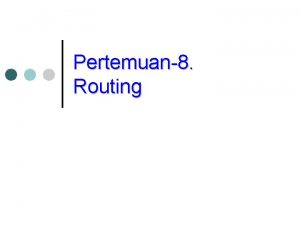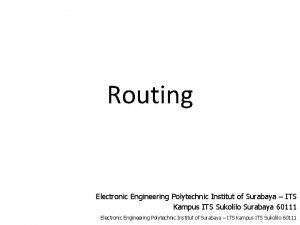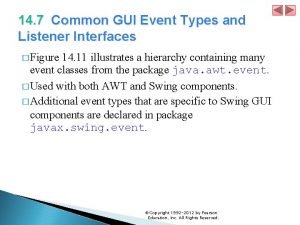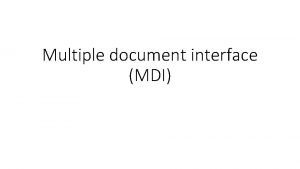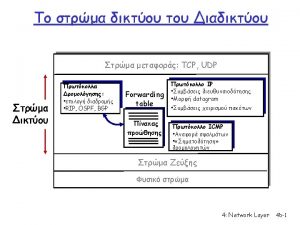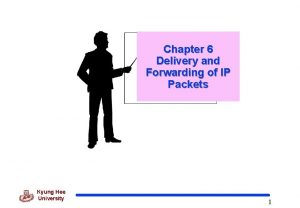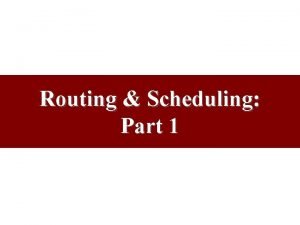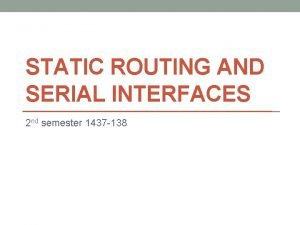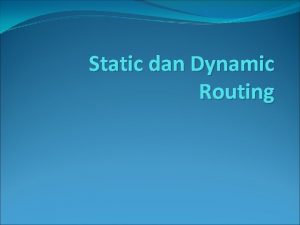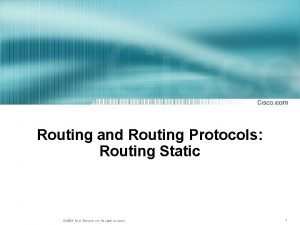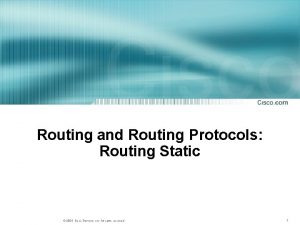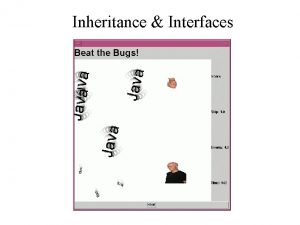STATIC ROUTING AND SERIAL INTERFACES 2 nd semester














































- Slides: 46

STATIC ROUTING AND SERIAL INTERFACES 2 nd semester 1437 -138

Outline • Static Routing Implementation • Configure Static and Default Routes • Review of CIDR • Configure Summary and Floating Static Routes • Troubleshoot Static and Default Route Issues • Summary

Static Routing Reach Remote Networks A router can learn about remote networks in one of two ways: • Manually - Remote networks are manually entered into the route table using static routes. • Dynamically - Remote networks are automatically learned using a dynamic routing protocol.

Static Routing Static route • A static route is created, maintained, and updated by a network administrator, manually. • A static route to every network must be configured on every router for full connectivity.



Static Routing Why Use Static Routing? Static routing provides some advantages over dynamic routing, including: Static routes are not advertised over the network, resulting in better security. Routers not share static routes with each other, thus reducing CPU/RAM overhead and saving bandwidth.

Static Routing Why Use Static Routing? (continued) Static routing has the following disadvantages: Initial configuration and maintenance is time-consuming. Configuration is error-prone, especially in large networks. Administrator intervention is required to maintain changing route information. Does not scale well with growing networks; maintenance becomes cumbersome. Requires complete knowledge of the whole network for proper implementation.

Static Routing When to Use Static Routes Static routing has three primary uses: Small networks: Providing ease of routing table maintenance in smaller networks that are not expected to grow significantly. Default route: Using a single default route to represent a path to any network that does not have a more specific match with another route in the routing table. Default routes are used to send traffic to any destination beyond the next upstream router.

Static Routing When to Use Static Routes • Routing to and from stub networks. A stub network is a network accessed by a single route, and the router has no other neighbors (only one router).

Static Routing Activity - Identify the Advantages and Disadvantages of Static Routing

Types of Static Routes Static Route Applications Static Routes are often used to: 1. Connect to a specific network 2. Provide a Gateway of Last Resort for a stub network 3. Summarize routing table entries 4. Create a backup route in case a primary route link fails

Types of Static Routes Standard Static Route Static route can be used to connect to a specific network ( like for example a stub network)

Types of Static Routes Default Static Route Static route can be used to configure default route. A default static route is a route that matches all packets. A default route identifies the gateway IP address to which the router sends all IP packets that it does not have a learned or static route. A default static route is simply a static route with 0. 0/0 as the destination IPv 4 address. Configuring a default static route creates a Gateway of Last Resort.

Types of Static Routes Default Static Route • Default static routes are used: • When no other routes in the routing table match the packet destination IP address. • When a router has only one other router to which it is connected. This condition is known as a stub router.

Types of Static Routes Summary Static Route

Types of Static Routes Summary Static Route To reduce the number of routing table entries, multiple static routes can be summarized into a single static route if: • The destination networks are contiguous and can be summarized into a single network address. • The multiple static routes all use the same exit interface or next-hop IP address.

Types of Static Routes Floating Static Route Floating static routes are static routes that are used to provide a backup path to a primary static or dynamic route, in the event of a link failure. The floating static route is only used when the primary route is not available. In order to accomplish this, the floating static route is configured with a higher administrative distance than the primary route.

Types of Static Routes Activity - Identify the Type of Static Route

Configure IPv 4 Static Routes ip route Command Next hop

Configure IPv 4 Static Routes Next-Hop Options The next hop can be identified by an IP address, exit interface, or both. How the destination is specified creates one of the three following route types: When only the next-hop IP address is specified Nexthop static route. When only the router exit interface is specified Directly connected static route. When the next-hop IP address and exit interface are specified Fully specified static route.

Configure IPv 4 Static Routes Configure a Next-Hop Static Route

Configure IPv 4 Static Routes Configure a Next-Hop Static Route • In a next-hop static route, only the next-hop IP address is specified. • The output interface is derived from the next hop. • The router performs multiple lookups in the routing table before forwarding a packet( a recursive lookup). • Because recursive lookups consume router resources, they should be avoided when possible.

Configure IPv 4 Static Routes Configure Directly Connected Static Route When configuring a static route, another option is to use the exit interface to specify the next-hop address.

Configure IPv 4 Static Routes Configure Directly Connected Static Route • Configuring a directly connected static route with an exit interface allows the routing table to resolve the exit interface in a single search, instead of two searches. • Although the routing table entry indicates “directly connected”, the administrative distance of the static route is still 1. Only a directly connected interface can have an administrative distance of 0. • Note: For point-to-point interfaces, you can use static routes that point to the exit interface or to the next-hop address. For multipoint/broadcast interfaces, it is more suitable to use static routes that point to a next-hop address.

Configure IPv 4 Static Routes Configure a Fully Specified Static Route In a fully specified static route, both the output interface and the next-hop IP address are specified. This is another type of static route that is used in older IOS’s, prior to CEF. This form of static route is used when the output interface is a multi-access interface and it is necessary to explicitly identify the next hop. The next hop must be directly connected to the specified exit interface.

Configure IPv 4 Static Routes Configure a Fully Specified Static Route

Configure IPv 4 Static Routes Verify a Static Route Along with ping and traceroute, useful commands to verify static routes include: show ip route static show ip route network

Configure IPv 4 Static Routes Verify a Static Route

Configure IPv 4 Default Routes Default Static Route

Configure IPv 4 Default Routes Configure a Default Static Route

Configure IPv 4 Default Routes Verify a Default Static Route Note the asterisk (*)next to the route with code ‘S’. The asterisk indicates that this static route is a candidate default route, which is selected as the Gateway of Last Resort.

Classful Addressing Classful Network Addressing and Default Subnet Masks Class A Class B Class C

CIDR Classless Inter-Domain Routing Classful Addressing Waste 6. 3. 1. 4

CIDR and Route Summarization

CIDR Static Routing CIDR Example

Configure IPv 4 Summary Routes Calculate a Summary Route

Configure IPv 4 Summary Routes Route Summarization CIDR is a form of route summarization and is synonymous with the term supernetting. CIDR ignores the limitation of classful boundaries, and allows summarization with masks that are smaller than that of the default classful mask. This type of summarization helps reduce the number of entries in routing updates and lowers the number of entries in local routing tables.

Configure IPv 4 Summary Routes Summary Static Route Example

Types of Static Routes Activity - Determine the Summary Network Address and Prefix

Configure Floating Static Routes Floating static routes are static routes that have an administrative distance greater than the administrative distance of another static route or dynamic routes. The administrative distance of a static route can be increased to make the route less desirable than that of another static route or a route learned through a dynamic routing protocol. In this way, the static route “floats” and is not used when the route with the better administrative distance is active. However, if the preferred route is lost, the floating static route can take over, and traffic can be sent through this alternate route.

Configure Floating Static Routes Configure a Floating Static Route Default static route Floating default static route

Configure Floating Static Routes Test the Floating Static Route Use a show ip route command to verify that the routing table is using the default static route. Use a traceroute command to follow the traffic flow out the primary route. Disconnect the primary link or shutdown the primary exit interface. Use a show ip route command to verify that the routing table is using the floating static route. Use a traceroute command to follow the traffic flow out the backup route.

Troubleshoot IPv 4 Static and Default Route Configuration Troubleshoot a Missing Route Common IOS troubleshooting commands include: ping traceroute show ip interface brief show cdp neighbors detail 6. 5. 2. 1

Summary Static routes can be configured with a next-hop IP address, which is commonly the IP address of the next-hop router. When a next-hop IP address is used, the routing table process must resolve this address to an exit interface. On point-to-point serial links, it is usually more efficient to configure the static route with an exit interface. On multi-access networks, such as Ethernet, both a next-hop IP address and an exit interface can be configured on the static route. Static routes have a default administrative distance of "1".

Summary (continued) A static route is only entered in the routing table if the next-hop IP address can be resolved through an exit interface. Whether the static route is configured with a next-hop IP address or exit interface, if the exit interface that is used to forward that packet is not in the routing table, the static route is not included in the routing table. In many cases, several static routes can be configured as a single summary route. If there is not a more specific match in the routing table, the routing table uses the default route to forward the packet to another router. A floating static route can be configured to back up a main link by manipulating its administrative value.
 Static routing and dynamic routing
Static routing and dynamic routing Goodrich method
Goodrich method Hydrologic continuity equation
Hydrologic continuity equation Clock routing in vlsi
Clock routing in vlsi Difference between dynamic and static routing
Difference between dynamic and static routing Tabel routing static
Tabel routing static Konfigurasi routing static
Konfigurasi routing static Konfigurasi static routing
Konfigurasi static routing Parallel input parallel output
Parallel input parallel output Serial soap opera
Serial soap opera Asht splint classification system
Asht splint classification system What is difference between abstract class and interface
What is difference between abstract class and interface Interface and abstract class difference in java
Interface and abstract class difference in java Dialogue sequence diagram
Dialogue sequence diagram Common gui event types and listener interfaces in java
Common gui event types and listener interfaces in java Colloids and interfaces
Colloids and interfaces Expressive interfaces
Expressive interfaces Web based interface
Web based interface Uml interfaces are used to:
Uml interfaces are used to: Industrial interfaces
Industrial interfaces What are expressive interfaces?
What are expressive interfaces? Blueprint interfaces
Blueprint interfaces Which is not an objective of designing interfaces?
Which is not an objective of designing interfaces? Property management system interfaces
Property management system interfaces Java static import
Java static import Joe hogan openet
Joe hogan openet Always visible tools in hci
Always visible tools in hci Bts gsm
Bts gsm Expressive interfaces
Expressive interfaces Bad srs document
Bad srs document Team interfaces
Team interfaces Micros e interfaces
Micros e interfaces Why are user interfaces hard to implement
Why are user interfaces hard to implement Design heuristic
Design heuristic What is mdi
What is mdi Programming graphical user interfaces in r
Programming graphical user interfaces in r Interfaces inteligentes
Interfaces inteligentes Abstract classes in java
Abstract classes in java User interfaces design dc
User interfaces design dc What is interfaces
What is interfaces F-14
F-14 Communication interface in embedded systems
Communication interface in embedded systems Ortec routing and dispatch
Ortec routing and dispatch Interplay between routing and forwarding
Interplay between routing and forwarding Delivery and routing of ip packets
Delivery and routing of ip packets Principles of good routing and scheduling
Principles of good routing and scheduling Advantages and disadvantages of distance vector routing
Advantages and disadvantages of distance vector routing






